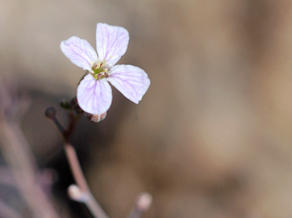Trekking through Catalina’s canyons, his eyes trained on the ground, Peter Dixon is on a quest. The Catalina Island Conservancy’s plant conservation manager is searching for one of 32 rare or endangered plants on Catalina, a tiny flowering annual known as the Thread-leaf rock cress (Sibara filifolia).
Trekking through Catalina’s canyons, his eyes trained on the ground, Peter Dixon is on a quest. The Catalina Island Conservancy’s plant conservation manager is searching for one of 32 rare or endangered plants on Catalina, a tiny flowering annual known as the Thread-leaf rock cress (Sibara filifolia).
Once thought to be extinct on Catalina, Dixon and others have documented the presence of this elusive member of the mustard family on Catalina through forays into the far reaches of the Island. This boots-on-the-ground approach, aided by the latest technology in habitat modeling, illustrates the importance biologists place on protecting biodiversity on Catalina and on islands around the globe.
“Biodiversity is the richness and wonder of life, and the loss of any of the flora or fauna, particularly insular endemics, is a loss of the natural heritage of that place,” said Dixon. “Discovering and documenting rare and endangered species, like the Thread-leaf rock cress, help us understand the habitats they need so that we can protect those species and the biological diversity that is so critical to understanding the past and our future.”
Catalina and the other Channel Islands are often referred to as the “Galapagos of North America” because they harbor a tremendous diversity of plants and animals, including a disproportionately high number of species that are unique to the islands, called endemic species. Catalina alone has more than 60 endemic species identified so far, with surveys, like the one Dixon is conducting, seeking to document more.
Island species face greater risk of extinction because of the unique evolution of island ecosystems.
The Global Island Partnership reports that about half of the 724 recorded animal extinctions in the last 400 years were island species, and at least 90 percent of the bird species that have become extinct in that period were island-dwellers.
The causes for the demise of these species are similar to those on the mainland: invasive plants and animals, human activities, climate change, pollution and other pressures.
But islands are more vulnerable because species may be present in relatively small numbers, making extinction more likely. Island species also may have evolved free of predation and competition from other species, so they haven’t developed protective mechanisms.
The population of the Catalina Island fox, for instance, was about 1,300 before a stowaway raccoon brought canine distemper virus to the Island.
The foxes had no natural immunity to the illness, and their numbers dropped to about 100 in 1999.
The Conservancy, working in partnership with the Institute for Wildlife Studies, was able to bring the fox back from the brink of extinction.
“We face special challenges in protecting biodiversity on Catalina because it is an Island with many introduced species and significant impact from humans,” said Tony Budrovich, Conservancy president and CEO. “With the Conservancy’s dedicated conservation staff and its collaborations with many others, we are conducting studies and methods for protecting the Island’s native species. In doing so, we ensure that Catalina serves as a living laboratory for protecting biodiversity on other islands and the mainland.”











